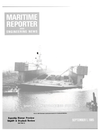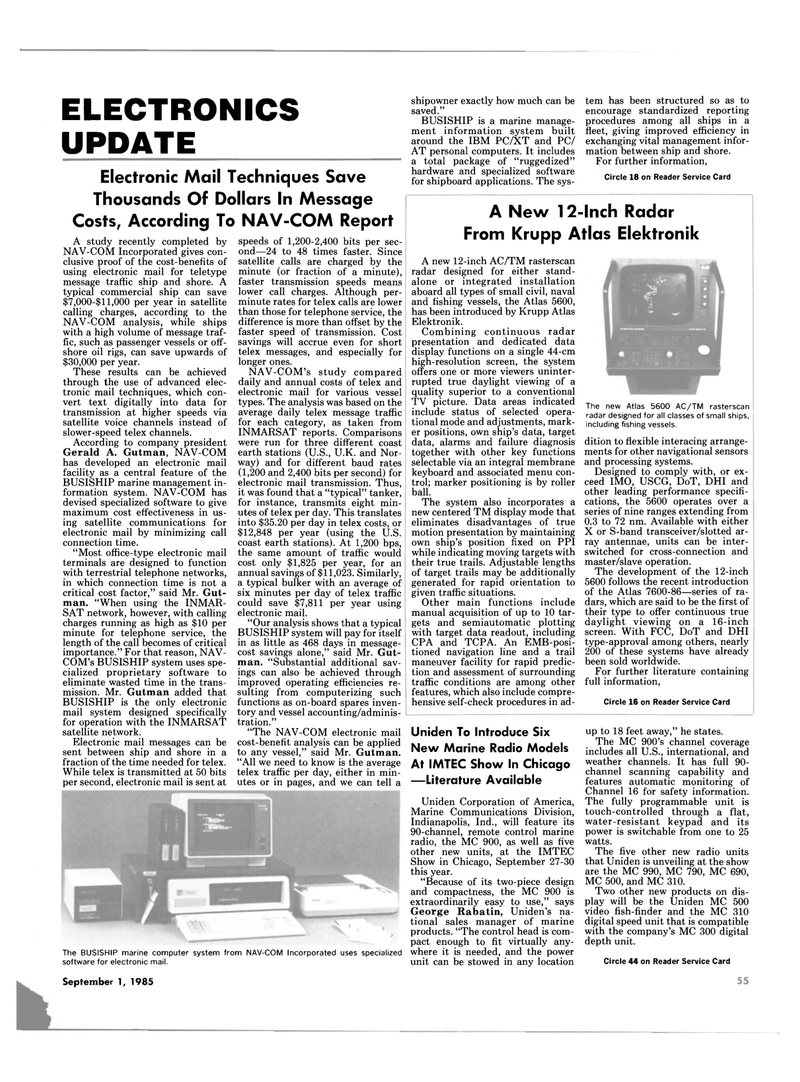
Page 53: of Maritime Reporter Magazine (September 1985)
Read this page in Pdf, Flash or Html5 edition of September 1985 Maritime Reporter Magazine
ELECTRONICS
UPDATE
Electronic Mail Techniques Save
Thousands Of Dollars In Message
Costs, According To NAV-COM Report
A study recently completed by
NAV-COM Incorporated gives con- clusive proof of the cost-benefits of using electronic mail for teletype message traffic ship and shore. A typical commercial ship can save $7,000-$ 11,000 per year in satellite calling charges, according to the
NAV-COM analysis, while ships with a high volume of message traf- fic, such as passenger vessels or off- shore oil rigs, can save upwards of $30,000 per year.
These results can be achieved through the use of advanced elec- tronic mail techniques, which con- vert text digitally into data for transmission at higher speeds via satellite voice channels instead of slower-speed telex channels.
According to company president
Gerald A. Gutman, NAV-COM has developed an electronic mail facility as a central feature of the
BUSISHIP marine management in- formation system. NAV-COM has devised specialized software to give maximum cost effectiveness in us- ing satellite communications for electronic mail by minimizing call connection time. "Most office-type electronic mail terminals are designed to function with terrestrial telephone networks, in which connection time is not a critical cost factor," said Mr. Gut- man. "When using the INMAR-
SAT network, however, with calling charges running as high as $10 per minute for telephone service, the length of the call becomes of critical importance." For that reason, NAV-
COM's BUSISHIP system uses spe- cialized proprietary software to eliminate wasted time in the trans- mission. Mr. Gutman added that
BUSISHIP is the only electronic mail system designed specifically for operation with the INMARSAT satellite network.
Electronic mail messages can be sent between ship and shore in a fraction of the time needed for telex.
While telex is transmitted at 50 bits per second, electronic mail is sent at speeds of 1,200-2,400 bits per sec- ond—24 to 48 times faster. Since satellite calls are charged by the minute (or fraction of a minute), faster transmission speeds means lower call charges. Although per- minute rates for telex calls are lower than those for telephone service, the difference is more than offset by the faster speed of transmission. Cost savings will accrue even for short telex messages, and especially for longer ones.
NAV-COM's study compared daily and annual costs of telex and electronic mail for various vessel types. The analysis was based on the average daily telex message traffic for each category, as taken from
INMARSAT reports. Comparisons were run for three different coast earth stations (U.S., U.K. and Nor- way) and for different baud rates (1,200 and 2,400 bits per second) for electronic mail transmission. Thus, it was found that a "typical" tanker, for instance, transmits eight min- utes of telex per day. This translates into $35.20 per day in telex costs, or $12,848 per year (using the U.S. coast earth stations). At 1,200 bps, the same amount of traffic would cost only $1,825 per year, for an annual savings of $11,023. Similarly, a typical bulker with an average of six minutes per day of telex traffic could save $7,811 per year using electronic mail. "Our analysis shows that a typical
BUSISHIP system will pay for itself in as little as 468 days in message- cost savings alone," said Mr. Gut- man. "Substantial additional sav- ings can also be achieved through improved operating efficiencies re- sulting from computerizing such functions as on-board spares inven- tory and vessel accounting/adminis- tration." "The NAV-COM electronic mail cost-benefit analysis can be applied to any vessel," said Mr. Gutman. "All we need to know is the average telex traffic per day, either in min- utes or in pages, and we can tell a shipowner exactly how much can be saved."
BUSISHIP is a marine manage- ment information system built around the IBM PC/XT and PC/
AT personal computers. It includes a total package of "ruggedized" hardware and specialized software for shipboard applications. The sys- tem has been structured so as to encourage standardized reporting procedures among all ships in a fleet, giving improved efficiency in exchanging vital management infor- mation between ship and shore.
For further information,
Circle 18 on Reader Service Card
A New 12-Inch Radar
From Krupp Atlas Elektronik
A new 12-inch AC/TM rasterscan radar designed for either stand- alone or integrated installation aboard all types of small civil, naval and fishing vessels, the Atlas 5600, has been introduced by Krupp Atlas
Elektronik.
Combining continuous radar presentation and dedicated data display functions on a single 44-cm high-resolution screen, the system offers one or more viewers uninter- rupted true daylight viewing of a quality superior to a conventional
TV picture. Data areas indicated include status of selected opera- tional mode and adjustments, mark- er positions, own ship's data, target data, alarms and failure diagnosis together with other key functions selectable via an integral membrane keyboard and associated menu con- trol; marker positioning is by roller ball.
The system also incorporates a new centered TM display mode that eliminates disadvantages of true motion presentation by maintaining own ship's position fixed on PPI while indicating moving targets with their true trails. Adjustable lengths of target trails may be additionally generated for rapid orientation to given traffic situations.
Other main functions include manual acquisition of up to 10 tar- gets and semiautomatic plotting with target data readout, including
CPA and TCPA. An EMB-posi- tioned navigation line and a trail maneuver facility for rapid predic- tion and assessment of surrounding traffic conditions are among other features, which also include compre- hensive self-check procedures in ad-
The new Atlas 5600 AC/TM rasterscan radar designed for all classes of small ships, including fishing vessels. dition to flexible interacing arrange- ments for other navigational sensors and processing systems.
Designed to comply with, or ex- ceed IMO, USCG, DoT, DHI and other leading performance specifi- cations, the 5600 operates over a series of nine ranges extending from 0.3 to 72 nm. Available with either
X or S-band transceiver/slotted ar- ray antennae, units can be inter- switched for cross-connection and master/slave operation.
The development of the 12-inch 5600 follows the recent introduction of the Atlas 7600-86—series of ra- dars, which are said to be the first of their type to offer continuous true daylight viewing on a 16-inch screen. With FCC, DoT and DHI type-approval among others, nearly 200 of these systems have already been sold worldwide.
For further literature containing full information,
Circle 16 on Reader Service Card
The BUSISHIP marine computer system from NAV-COM Incorporated uses specialized software for electronic mail.
Uniden To Introduce Six
New Marine Radio Models
At IMTEC Show In Chicago —Literature Available
Uniden Corporation of America,
Marine Communications Division,
Indianapolis, Ind., will feature its 90-channel, remote control marine radio, the MC 900, as well as five other new units, at the IMTEC
Show in Chicago, September 27-30 this year. "Because of its two-piece design and compactness, the MC 900 is extraordinarily easy to use," says
George Rabatin, Uniden's na- tional sales manager of marine products. "The control head is com- pact enough to fit virtually any- where it is needed, and the power unit can be stowed in any location up to 18 feet away," he states.
The MC 900's channel coverage includes all U.S., international, and weather channels. It has full 90- channel scanning capability and features automatic monitoring of
Channel 16 for safety information.
The fully programmable unit is touch-controlled through a flat, water-resistant keypad and its power is switchable from one to 25 watts.
The five other new radio units that Uniden is unveiling at the show are the MC 990, MC 790, MC 690,
MC 500, and MC 310.
Two other new products on dis- play will be the Uniden MC 500 video fish-finder and the MC 310 digital speed unit that is compatible with the company's MC 300 digital depth unit.
Circle 44 on Reader Service Card
September 1, 1985 55

 52
52

 54
54
